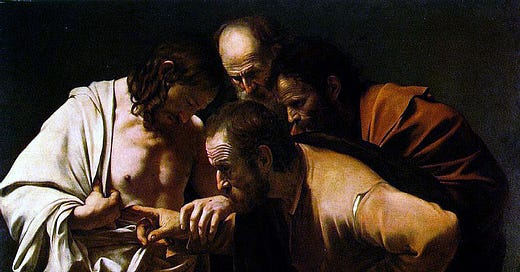Art as a Path to Wisdom: Caravaggio and Jigyasu Bhava.
His paintings became a mirror of the soul.
The story of Michelangelo Merisi, known as Caravaggio, offers us a shining example of jigyasu bhava, the thirst for knowledge that is at the core of Vedanta philosophy.
During his time in Rome at the Church of Santa Maria della Vallicella, Caravaggio came into contact with the poor and marginalized people that the order assisted. This encounter was a revelation and inspiration for him. In the weathered faces of those men and women, the painter saw reflected the very essence of human nature. He then decided to make them the subjects of his paintings, giving them dignity and a voice through his sublime art.
Thus, beggars, peasants and outcasts became the protagonists of his canvases. Chiaroscuro, masterfully modulated, gave an almost sacred intensity to their features. Caravaggio was able to capture the soul that dwelled in those tried bodies and portrayed it with unmatched mastery.
Jigyasu bhava, the thirst for knowledge, guided his brush. The urge to dig beneath the surface, to unveil the hidden truths of existence. Just as Vedanta teaches us to look beyond misleading appearances. Every crease and every expression was studied and immortalized on canvas. Caravaggio knew that even the lowest people could reflect the Divine light. One just had to learn to see with the eyes of the Spirit.
Thus his paintings became a mirror of the soul. His works immediately aroused empathy, as they spoke directly to the viewer's heart. They still today move and question our conscience. They are the fruit of that jigyasu bhava, of that sincere quest for Truth, that Caravaggio embodied through his unforgettable art.
He celebrated life in its many forms, even the humblest. He reminded us that beauty lies everywhere if only we learn to look with pure, contemplative eyes.
What an eternal lesson this great master has left us with his work! Opening oneself to the divine essence present in all beings is the path to elevate from ignorance and access supreme wisdom. However, Caravaggio's artistic innovation was not understood by his contemporaries, especially within ecclesiastic circles. He broke the rigid conventions of the time, which required idealized, stereotypical subjects for sacred art.
His realistically depicted poor people, rendered without embellishment or rhetorical emphasis, appeared almost blasphemous to some. They were too human, too real, lacking the formal sacredness expected of devotional art.
For Caravaggio, however, the essential thing was to capture the soul of his subjects. He wasn't interested in abstract ideals but in the concrete reality of the faces he observed. Only in this way did he think he could unveil the deepest truths about the human condition. This perspective was groundbreaking and destabilizing. The Church struggled to accept works so different from traditional canons. How could dirty, suffering beggars convey the divine message?
Yet Caravaggio did not let himself be influenced by criticisms or lack of understanding. His jigyasu bhava, his thirst for Truth, was more potent than conventions. He knew he had to be faithful only to his intense spirit of inquiry.
Thanks to his perseverance, today we can admire masterpieces that speak directly to our hearts and minds. Caravaggio paved the way for a profoundly human realism in sacred art, which still appears revolutionary today. He taught us that to portray the essence of the divine one must observe and exalt life in all its manifestations. Even those considered most humble and insignificant.
Beauty and wisdom are everywhere, one only needs to look with the pure eyes of contemplation. This is jigyasu bhava: making ourselves pilgrims of Truth, without being misled by prejudices or illusory appearances.
Caravaggio embodied this uncompromising quest through his exceptional masterpieces. He left us an artistic and spiritual heritage that still today illuminates and moves the spirit of those who contemplate it.
I have woven tales to share, for any who care to read them. My books await you on Google Books. Check also my stories on Medium.com.




